Solar battery on the balcony: testing battery ionistor
Hi geektimes.
The previous part was about testing lithium batteries for storing electricity. In one of the comments was a question about the use of ionistors for storing stored energy. It became interesting to check how it works.
Of course, the parameters of ionics can be found in the datasheet and count all that is necessary. But it’s not so interesting, where it’s more interesting to measure yourself. For this, a board with a long name 6Pcs Farad Capacitor 2.7V 500F with Protection Board was ordered on ebay.
')
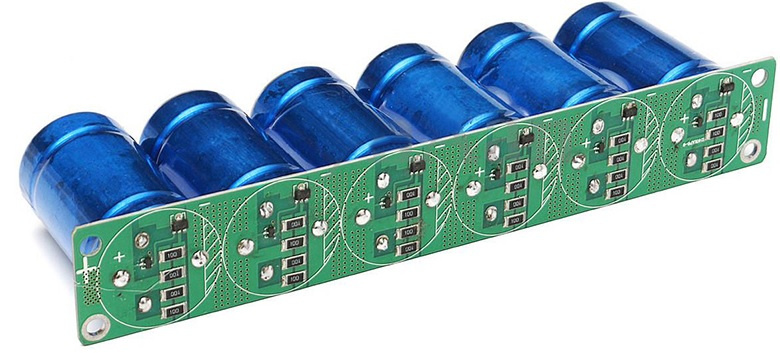
How it works, details under the cut.
What is interesting ionistor? It is, simply put, a huge capacitor - which can be hundreds of farads. Unlike batteries, ionistors have the following advantages:
- have almost unlimited number of cycles,
- can be discharged to zero, are not afraid of discharge,
- can work at negative temperatures,
- can give very large currents, tens or even hundreds of amps,
- have the main component - activated carbon, which is a very environmentally friendly and "renewable" component (if you believe Wikipedia, it is obtained from coconuts).
At the same time, ionistors have disadvantages:
- energy density is 10-100 times less than that of batteries,
- unlike batteries, the voltage at load drops immediately and linearly,
- high price.
To be fair, the technology is not so new: my old Palm m105 was also able to work from the built-in ionistor for 1-2 minutes while the user changed the battery. However, the price of high capacity ionistors has dropped quite noticeably, which makes it possible to buy them without large financial expenses.
One of the features of ionics - the voltage of each element does not exceed 2.7V. Therefore, to obtain large voltages, they are connected to a battery, and in order not to recharge each element, they are equipped with a protection circuit. The principle is completely analogous to the balancer in lithium batteries - when the voltage is exceeded, the excess is etched on the resistors. The protection scheme can be clearly seen on the photo above. In my case, the battery consists of 6 ionistors, with a capacity of 500F and a voltage of 2.7V each, thus the maximum battery voltage is about 16V.
The second interesting feature of ionistors is a very small internal resistance. An ionistor can both receive and give currents of tens of amps (there is an informative video on this topic). In my case, when I first tried to charge the ionistor from the power supply 12Vx8A, the wire was red-hot and burned out. I had to get the power supply with the current limit setting, then the charging process went fine. Otherwise, the charge of the ionistor is no different from the charge of the capacitor.
As a first test, an LED strip was connected directly to the ionistor. It was interesting to check the possibility of using the most simple "emergency" lighting, without any complicated drivers. In order not to spoil the ribbon LEDs, the ionistors were charged up to 12V. From previous experiments it was known that the current consumption of this piece of tape at 12V is 1A.
Results on the photo:
1) 21:01, start, voltage 12V, the tape burns in full heat
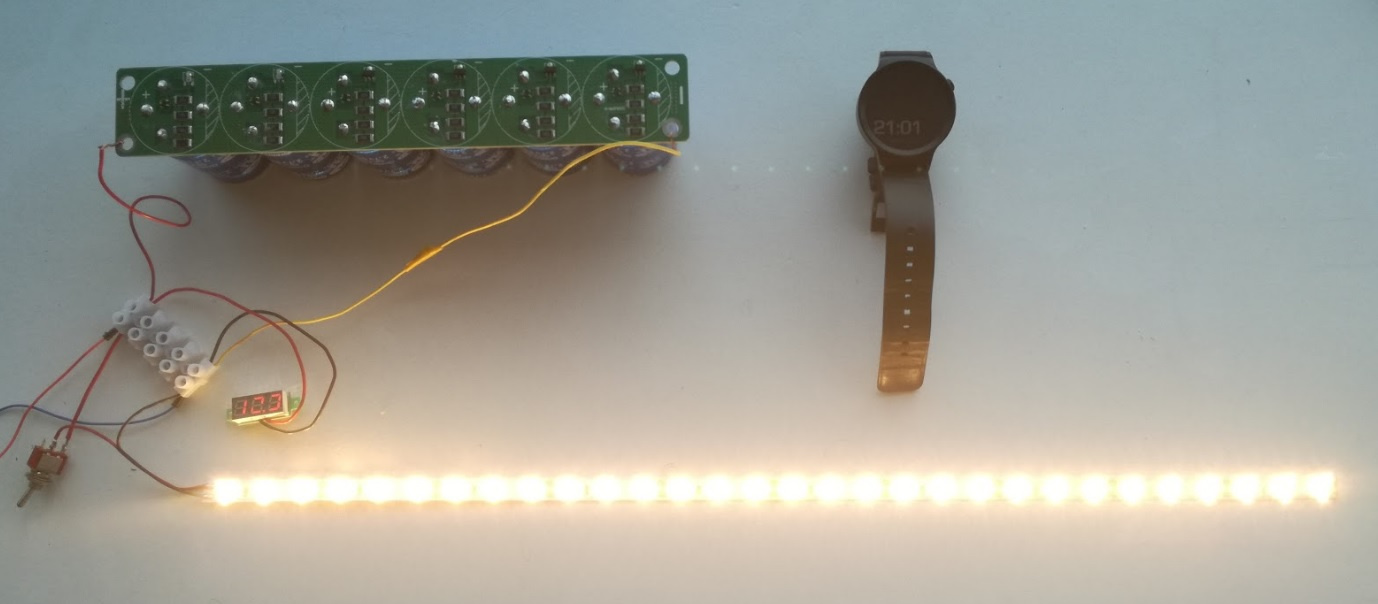
2) 21:09, the voltage has already dropped to 8.7V
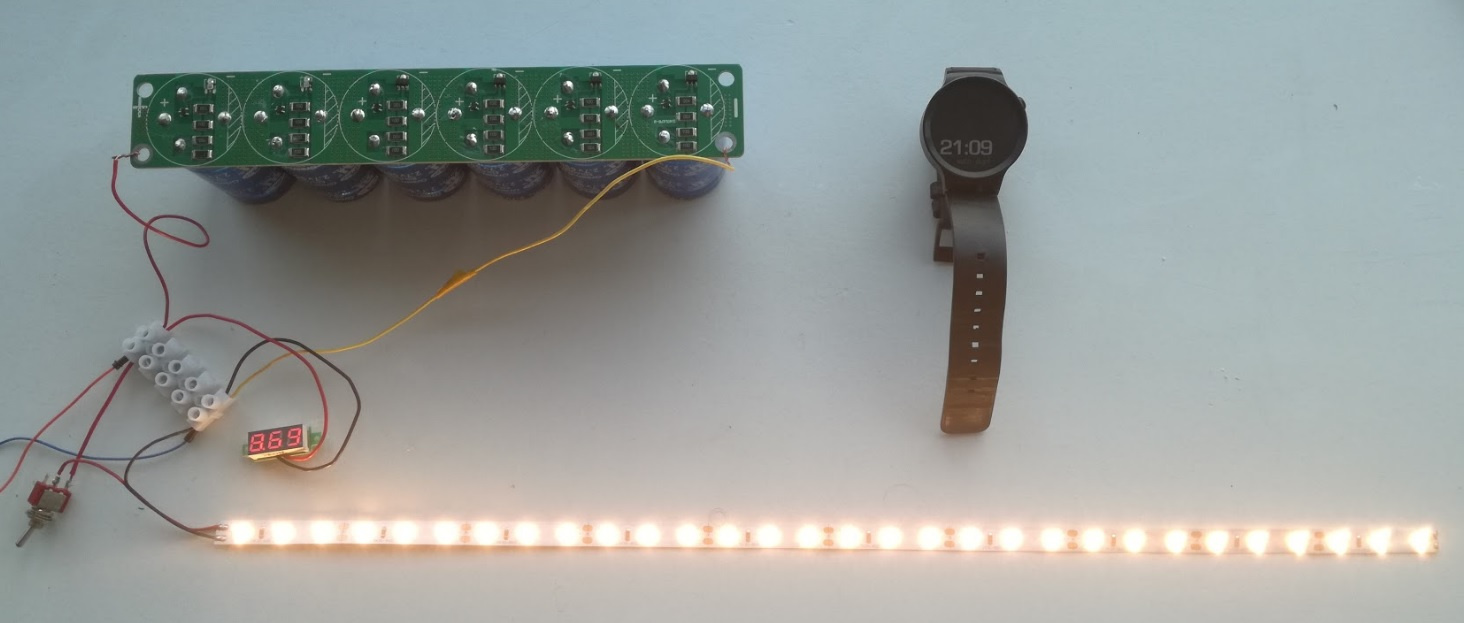
I thought that the tape was about to go out, but the current consumption clearly decreased.
3) 21:17, voltage 7.8V, the tape is still shining
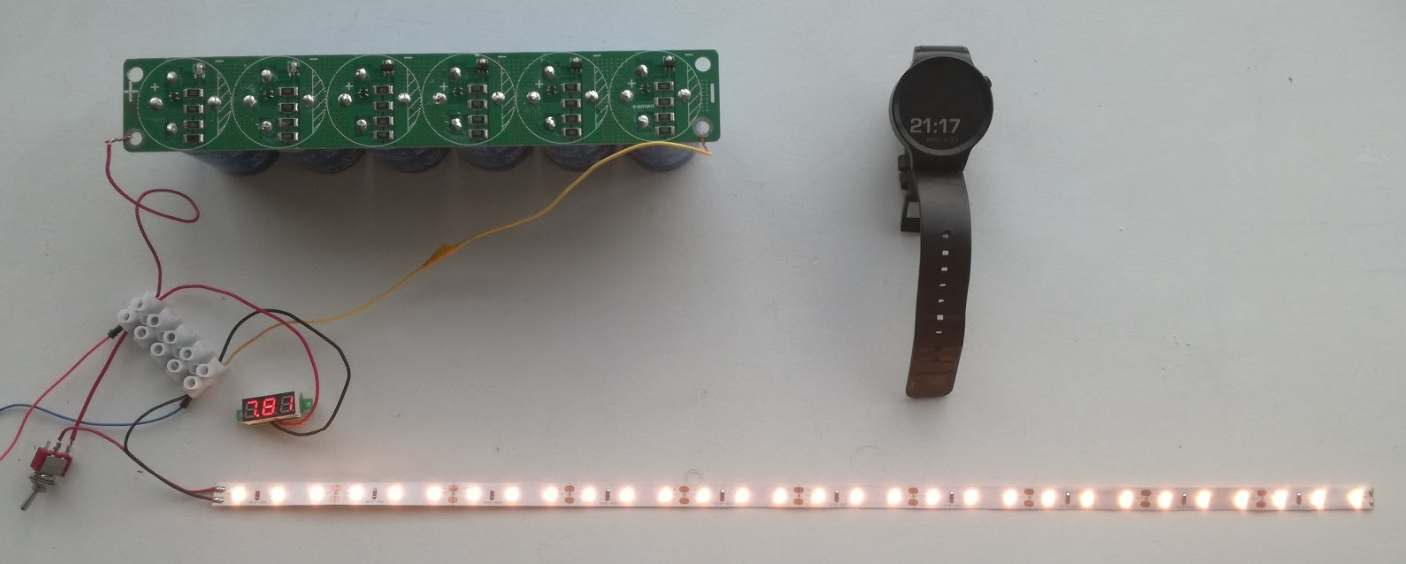
4) 21:31, half an hour has passed, but to my surprise, the tape still glows slightly, the voltage is 7.3V.
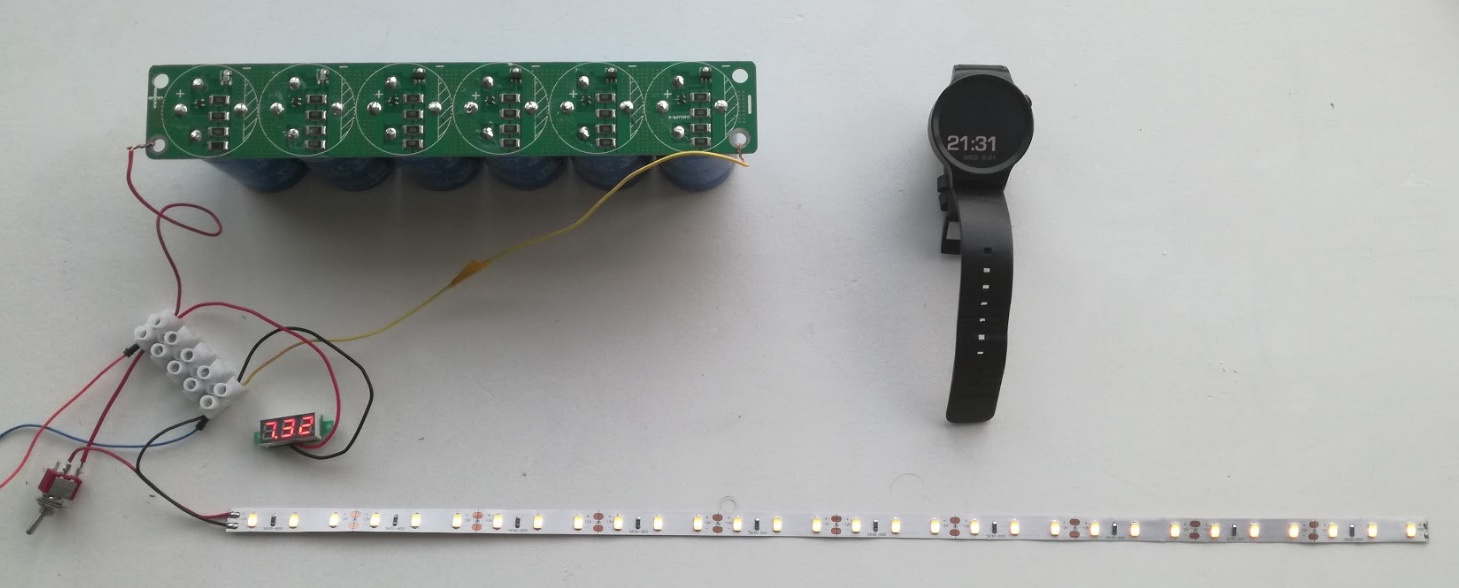
I was tired of waiting further, and it was difficult to call it a glow. It was decided to build a buck / boost converter capable of supplying the tape with a stabilized voltage of 12V. For this, a step-up 24V converter was connected, to the output of which a second step down converter, tuned to 12V, was connected. As a bonus, this allowed the ionistors to be fully charged up to 16V.
Everything looks like this (evening, the room has become darker, so that the photo tape is brighter):

The system really works, and when the output voltage began to decrease, the ionistor was discharged to 3.8V.

Result : the tape really burned without a visual change in brightness, the time of complete burning was 8 minutes.
If you measure in dollars per watt, then for $ 45 a battery was bought, from which the LED strip can burn for 8 minutes. Honestly, not very impressive, although something similar was expected in principle.
However, ionistors are quite interesting by the presence of very unique features:
- Almost unlimited number of cycles. It is interesting to make emergency LED lighting from solar panels, with an almost eternal service life,for example, for a toilet in the village . With the development of the IoT market, ionistors can be very promising for powering devices with low consumption.
- The ability to give large currents and the ability to work at low temperatures.
This allows you to use the ionistor as a buffer element, when you need to quickly give a large current with a weak source. The youtube described quite successful experiments on the use of ionistors in a car starter . With regard to solar energy, another interesting example is the short-term storage of energy for the operation of high-power devices (drills, saws) from a solar battery, can be found here:
- Potential environmental friendliness and simplicity of design of the ionistor. In youtube there is even a video on the independent production of supercapacitors, although it is difficult to say how realistic it is.
On the other hand, lithium-titanate batteries have almost the same advantages - a large number of cycles, the ability to work in the cold, and large surrendered currents. It is still difficult to say what will be better in the long run, and this and that now is rather exotic. Most likely the niche of ionistors will remain very narrow, but nevertheless it is.
Well, and a bonus for those who read to here: the measurement of the capacity of the ionistor battery when charging a smartphone can be viewed on my video .
Testing of the ionistor battery in conjunction with the solar panel will be described separately.
To be continued.
The previous part was about testing lithium batteries for storing electricity. In one of the comments was a question about the use of ionistors for storing stored energy. It became interesting to check how it works.
Of course, the parameters of ionics can be found in the datasheet and count all that is necessary. But it’s not so interesting, where it’s more interesting to measure yourself. For this, a board with a long name 6Pcs Farad Capacitor 2.7V 500F with Protection Board was ordered on ebay.
')

How it works, details under the cut.
What is interesting ionistor? It is, simply put, a huge capacitor - which can be hundreds of farads. Unlike batteries, ionistors have the following advantages:
- have almost unlimited number of cycles,
- can be discharged to zero, are not afraid of discharge,
- can work at negative temperatures,
- can give very large currents, tens or even hundreds of amps,
- have the main component - activated carbon, which is a very environmentally friendly and "renewable" component (if you believe Wikipedia, it is obtained from coconuts).
At the same time, ionistors have disadvantages:
- energy density is 10-100 times less than that of batteries,
- unlike batteries, the voltage at load drops immediately and linearly,
- high price.
To be fair, the technology is not so new: my old Palm m105 was also able to work from the built-in ionistor for 1-2 minutes while the user changed the battery. However, the price of high capacity ionistors has dropped quite noticeably, which makes it possible to buy them without large financial expenses.
Charge
One of the features of ionics - the voltage of each element does not exceed 2.7V. Therefore, to obtain large voltages, they are connected to a battery, and in order not to recharge each element, they are equipped with a protection circuit. The principle is completely analogous to the balancer in lithium batteries - when the voltage is exceeded, the excess is etched on the resistors. The protection scheme can be clearly seen on the photo above. In my case, the battery consists of 6 ionistors, with a capacity of 500F and a voltage of 2.7V each, thus the maximum battery voltage is about 16V.
The second interesting feature of ionistors is a very small internal resistance. An ionistor can both receive and give currents of tens of amps (there is an informative video on this topic). In my case, when I first tried to charge the ionistor from the power supply 12Vx8A, the wire was red-hot and burned out. I had to get the power supply with the current limit setting, then the charging process went fine. Otherwise, the charge of the ionistor is no different from the charge of the capacitor.
Testing
As a first test, an LED strip was connected directly to the ionistor. It was interesting to check the possibility of using the most simple "emergency" lighting, without any complicated drivers. In order not to spoil the ribbon LEDs, the ionistors were charged up to 12V. From previous experiments it was known that the current consumption of this piece of tape at 12V is 1A.
Results on the photo:
1) 21:01, start, voltage 12V, the tape burns in full heat

2) 21:09, the voltage has already dropped to 8.7V

I thought that the tape was about to go out, but the current consumption clearly decreased.
3) 21:17, voltage 7.8V, the tape is still shining

4) 21:31, half an hour has passed, but to my surprise, the tape still glows slightly, the voltage is 7.3V.

I was tired of waiting further, and it was difficult to call it a glow. It was decided to build a buck / boost converter capable of supplying the tape with a stabilized voltage of 12V. For this, a step-up 24V converter was connected, to the output of which a second step down converter, tuned to 12V, was connected. As a bonus, this allowed the ionistors to be fully charged up to 16V.
Everything looks like this (evening, the room has become darker, so that the photo tape is brighter):

The system really works, and when the output voltage began to decrease, the ionistor was discharged to 3.8V.

Result : the tape really burned without a visual change in brightness, the time of complete burning was 8 minutes.
findings
If you measure in dollars per watt, then for $ 45 a battery was bought, from which the LED strip can burn for 8 minutes. Honestly, not very impressive, although something similar was expected in principle.
However, ionistors are quite interesting by the presence of very unique features:
- Almost unlimited number of cycles. It is interesting to make emergency LED lighting from solar panels, with an almost eternal service life,
- The ability to give large currents and the ability to work at low temperatures.
This allows you to use the ionistor as a buffer element, when you need to quickly give a large current with a weak source. The youtube described quite successful experiments on the use of ionistors in a car starter . With regard to solar energy, another interesting example is the short-term storage of energy for the operation of high-power devices (drills, saws) from a solar battery, can be found here:
Video
- Potential environmental friendliness and simplicity of design of the ionistor. In youtube there is even a video on the independent production of supercapacitors, although it is difficult to say how realistic it is.
On the other hand, lithium-titanate batteries have almost the same advantages - a large number of cycles, the ability to work in the cold, and large surrendered currents. It is still difficult to say what will be better in the long run, and this and that now is rather exotic. Most likely the niche of ionistors will remain very narrow, but nevertheless it is.
Well, and a bonus for those who read to here: the measurement of the capacity of the ionistor battery when charging a smartphone can be viewed on my video .
Testing of the ionistor battery in conjunction with the solar panel will be described separately.
To be continued.
Source: https://habr.com/ru/post/373563/
All Articles